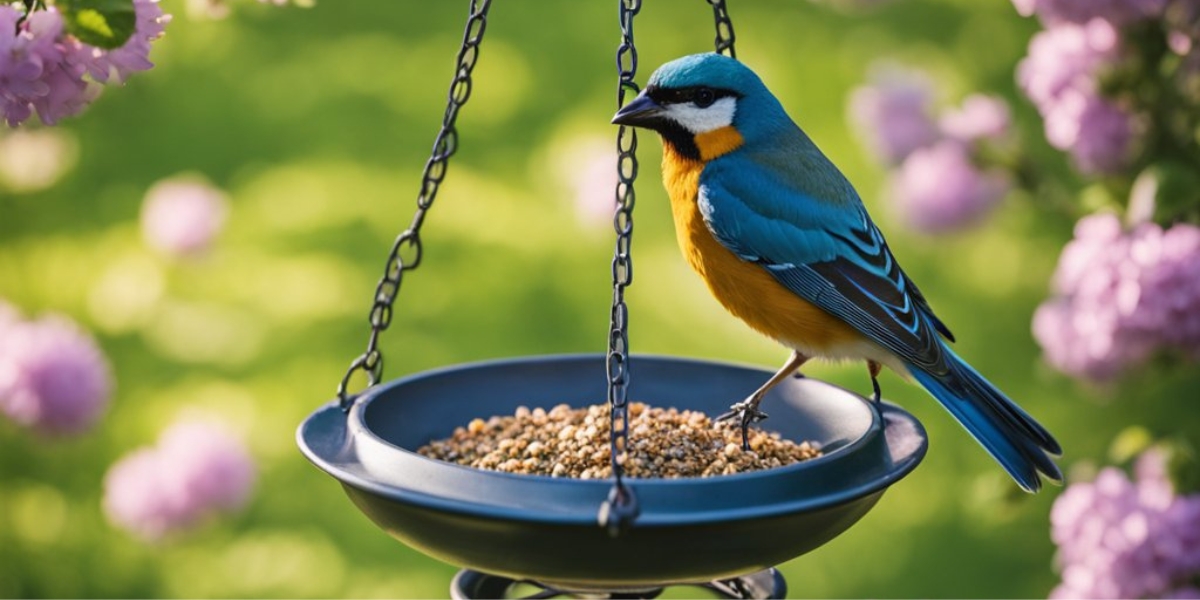Attracting birds to your backyard can bring joy, entertainment, and benefits to any outdoor space. Birds help control insects, pollinate plants, and add natural beauty. With some simple strategies, you can turn your yard into a birdwatcher’s paradise. Follow these tips to make your backyard a favorite stopover for many feathered friends.
Choose the Right Bird Feeders
The types of bird feeders you provide will determine what species frequent your yard. Place feeders in optimal locations to keep birds safe and supported.
Types of Feeders
Different feeder designs accommodate birds of various sizes while offering specialized menu items.
Hanging Feeders
Tubular or spherical hanging feeders work well for small birds that can perch and feed easily, including:
- Chickadees
- Titmice
- Goldfinches
- Finches
Hang these feeders from tree branches, porches, or specialized poles. Protect them from predators by positioning over 10 feet away from vegetation or cover.
Platform Feeders
Also called tray feeders, these flat, open designs invite larger birds like:
- Northern cardinals
- Blue jays
- Grosbeaks
- Doves
Mount platform feeders on poles, fences, or decks. Include a Catch tray underneath to collect fallen seed.
Hopper Feeders
These enclosed feeders protect seed from getting wet. Their large capacity holds plentiful food for all sizes of birds, including:
- Sparrows
- Cardinals
- Blackbirds
- Chickadees
Hang hopper feeders from hooks or mount on poles. Ensure drainage holes in the base to limit moisture.
Suet Feeders
Suet feeders offer high-fat nuts and seeds compressed into cakes. They attract insect-eating birds like:
- Woodpeckers
- Nuthatches
- Wrens
- Warblers
Specialized suet cage feeders limit access for larger birds. Hang them from trees or poles in areas sheltered from rain.
Placement Tips
Proper placement provides safety, shelter, and easy access:
- Position feeders at least 10-12 feet from trees, fences, and cover where predators lurk.
- Face feeder entrances toward open spaces for quick getaways.
- Set feeders at desired heights based on the species you want to welcome:
- 5-6 feet high for small birds
- 8-10 feet for larger birds
- Under 3 feet for ground feeders
- Place feeders in areas protected from wind and rain without becoming damp or moldy.
- Distribute multiple feeders throughout your yard to minimize crowding.
Maintenance
Regular cleaning and care makes feeders safe and sanitary for visiting birds:
- Wash feeders with a 10% bleach solution monthly or whenever they are visibly dirty. Rinse and dry thoroughly.
- Remove old, wet seed and seed hulls, which promote bacteria and fungus.
- Discard seed that smells musty or shows signs of mold.
- Replace feeder parts as needed to prevent harming birds.
- Adjust feeder placement seasonally as bird movement and behavior change.
Following feeder best practices will keep birds returning frequently to your backyard.
Select Bird-Friendly Foods
Offering a menu of enticing foods will satisfy the appetites of the diverse bird species in your yard.
Seed Options
Stock single or mixed seeds to attract certain birds.
Black-Oil Sunflower Seeds
The small size and thin shells make these seeds perfect for small-beaked birds. They are rich in fat and protein to sustain energy and body heat. Sunflower seeds entice:
- American Goldfinches
- Tufted Titmice
- Black-capped Chickadees
- House Finches
- Purple Finches
- Pine Siskins
Safflower Seeds
With a tough shell, these seeds appeal to birds with thicker beaks, like:
- Northern Cardinals
- Rose-breasted Grosbeaks
- Evening Grosbeaks
Safflower is less appealing to squirrels and blackbirds. It resists mold in damp weather.
Peanuts
Whole peanuts in the shell draw birds like:
- Blue Jays
- Red-bellied Woodpeckers
- Downy Woodpeckers
- Northern Flickers
Avoid peanuts for outdoor feeders if allergies are a concern. Salted peanuts can harm birds.
Fruit Options
Fruits add natural sweetness and variety to bird meals.
Fresh Fruit
Halved apples, oranges, bananas, melons, and berries attract:
- American Robins
- Gray Catbirds
- Waxwings
- Thrashers
- Orioles
Impale cut fruit on sticks wired to platform feeders or skewers onto tree branches.
Dried Fruit
Chopped raisins, cranberries, cherries, apricots, and dates appeal to the same fruit-loving species. Mix into seed blends or serve separately.
Soak dried fruit in water for an hour before serving to make it easier to digest.
Mixed Seed Blends
Pre-made mixes offer diverse nutrition from various seeds, nuts, grains, and dried fruit. These help satisfy many birds’ preferences with one feeder.
Look for blends with minimal filler seeds that birds ignore, like milo and wheat. Note ingredients to avoid mixes with undesirable additives.
Supplementing basic seed diets with suet, peanuts, and fresh fruit covers the dietary needs of backyard birds. Adjust offerings seasonally as bird habits and needs change.
Provide Water and Shelter
In addition to food sources, birds seek water for drinking and bathing. Sheltered housing provides safe nesting sites and refuge from the elements.
Birdbaths
Placing a small backyard pond or birdbath meets birds’ water needs for hydration and feather maintenance.
- Use shallow basins no more than 2-3 inches deep with sloping sides for safe access.
- Choose large baths over 20-inch diameter and 2-3 inches deep.
- Include a nearby perch like boulders or logs.
- Place baths near trees or bushes to provide quick cover from predators.
- Refill water frequently and clean baths weekly to prevent illness.
Installing a birdbath heater or pump keeps water thawed in winter months. Positioning baths in sunny spots also helps prevent freezing.
Birdhouses
Installing birdhouses offers shelter to raise children and rest.
Select a birdhouse style and placement suited to the desired species in your region. Ensure proper box dimensions with appropriate-sized entrance holes.
- Mount boxes at suitable heights on poles or trees.
- Face entrances away from prevailing winds and predators.
- Use untreated wood and non-toxic paints or stains.
- Add drainage holes and ventilation gaps.
- Include perches at entry holes for small cavity nesters.
- Limit the spacing between boxes to minimize territorial conflicts.
Routinely clean boxes to reduce parasites, diseases, and hazards for birds. Timely maintenance ensures safe nesting sites each season.
Create a Bird-Friendly Landscape
A natural landscape based on native plants suits the needs of local and migrating birds for food and shelter.
Native Plants
Incorporate native plant species evolved to thrive in your local climate and soil conditions without added watering or fertilizers. This habitat provides what regional birds need for nesting and nourishment.
- Plant native trees like oak, maple, pine, and fruit trees that produce seeds or fruits for birds.
- Include berry bushes like elderberry, serviceberry, and juniper.
- Grow native wildflowers, vines, grasses, and sedges for cover.
- Select flowering plants with different bloom times to supply nectar all season.
Variety of Plants
Ensure diversity in your plant choices for continuous food sources.
- Evergreen trees and shrubs provide shelter, nesting sites, and berries year-round.
- Summer-blooming plants supply nectar during the breeding season.
- Fall flowers and seed heads provide nourishment for migration.
- Leave perennial plant stems and seed heads over winter to furnish food.
- Grow berry bushes and fruit trees that yield summer, fall, and winter fruits.
Avoid Pesticides
Minimize or eliminate pesticide use, which can poison birds and diminish insect food sources.
- Remove pesky insects by hand and install screens or netting to protect plants.
- Introduce beneficial insects like ladybugs, which prey on plant pests.
- Apply natural repellents like neem oil to deter insect damage.
- Maintain healthy soil and promote plant vigor to resist diseases.
Other Features
Include diverse landscape elements to recreate natural bird habitats.
- Brush piles provide shelter and insect-hunting grounds.
- Dead trees offer nesting cavities.
- Butterfly gardens supply nectar and insect food.
- Small backyard ponds or fountains provide fresh water.
- Rock piles create lookout perches.
- Long grasses and sedges offer seeds, concealment, and nest material.
People Also Read:
Conclusion
Attracting a diversity of birds to your backyard is rewarding and enjoyable. Follow these tips to turn your outdoor space into a thriving bird sanctuary. Observing birds and their behaviors connects us to nature’s beauty and brings a bit of the wild into our lives. A flourishing bird population also benefits gardens through pollination and natural pest control. With thoughtful planning for food, water, shelter, and safety, you can entice fascinating feathery visitors to your yard.
FAQs
What time of year is best to start feeding birds?
The ideal time is late fall going into winter when natural food sources decline. Start stocking feeders in early November to establish feeding routines before cold weather arrives. Maintain feeders year-round once started.
How often should I clean my bird feeders?
Clean feeders at least once per month with a 10% bleach solution. Clean more frequently during wet weather when seed spoils faster. Discard moldy seed right away.
What is the best bird feeder setup for small yards?
Focus on hanging feeders like tube feeders and suet feeders which take up minimal space. Supplement with platform feeders mounted to walls or poles. Use more feeder styles if space allows.
Should I provide birdhouses for migrating birds passing through?
It’s unlikely migrating birds will nest in your boxes for just short stopovers. Cater boxes to residents or species you wish to attract as nesting pairs. Clean annually after breeding season.
How can I deter squirrels from my bird feeders?
Use feeders with weight-sensitive perches. Install baffles on poles to block climbing. Place feeders at least 15 feet from jumps and trees. Avoid mixes squirrels like containing corn, milo or sunflower hearts.

